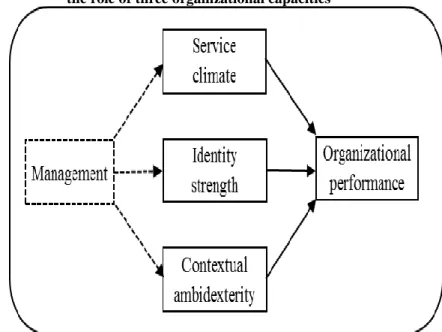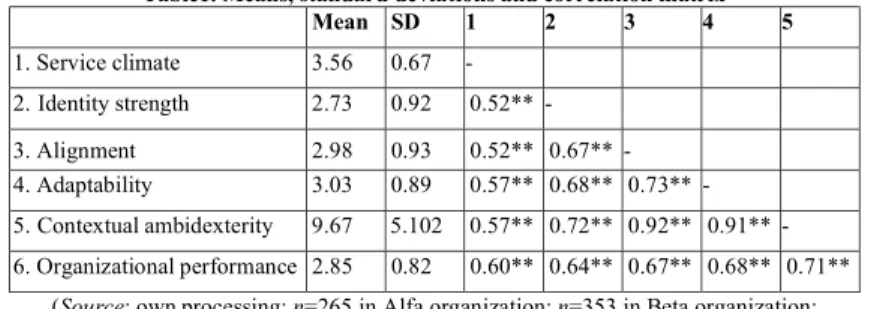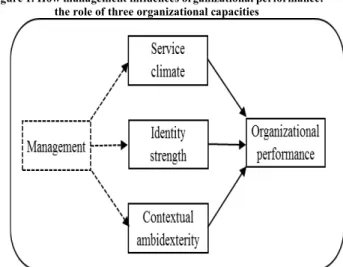Judul Article: The influence of service climate, identity strength and contextual ambidexterity on the performance of public organizations. However, probably due to the sheer diversity of public organizations and their respective contexts, these reviews highlight a number of inconsistencies regarding the way management and other organizational elements determine organizational performance. We propose that management influences organizational performance by nurturing the organizational capabilities of service climate, identity strength, and contextual ambidexterity.
More precisely, we investigate to what extent the three capacities service climate, identity strength and contextual ambidexterity influence the perception of organizational performance. Meta-analytic work reveals generalized support for this relationship between service climate and organizational performance (Hong et al., 2013). A strong organizational identity will influence organizational performance because it enables the reconciliation of the multiple and often conflicting goals within an organization, a very common feature of public organizations.
The results also support the second hypothesis, according to which identity strength would be positively related to organizational performance (β=0.19; p<0.01). The third hypothesis posits a positive relationship between contextual ambidexterity and organizational performance, and the results also support this assertion (β=0.43; p<0.01). This is important insofar as it invokes contextual factors that moderate the relationships between service climate, identity strength, and contextual ambidexterity and organizational performance.
Using hierarchical regression analysis, we found evidence supporting a positive relationship between organizational performance and service climate, identity strength, and especially contextual ambidexterity, with some differences between the two organizations in the intensity of these relationships. Organizational performance is also a core feature of reforms taking place in the public sector, whether or not these changes are inspired by New Public Management (Pollitt and Dan, 2013; Androniceanu, 2017). The influence of the service climate, identity strength and contextual ambidexterity on the performance of public organizations.
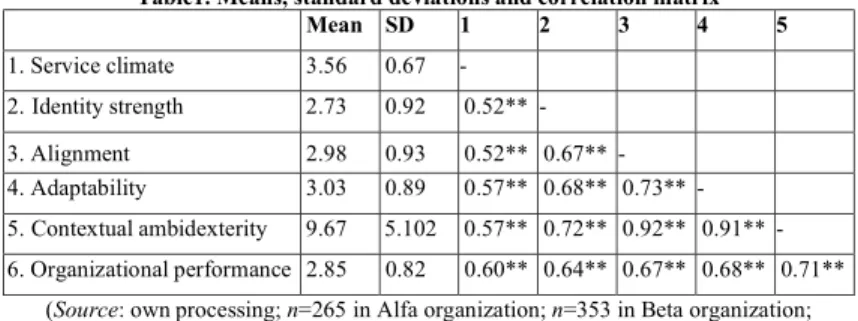
Literature review
How service climate influences organizational performance
How identity strength influences organizational performance
According to Boyn (2002), due to their inherently political nature, public organizations tend to pursue multiple and ambiguous goals. Influenced by different interest groups, with inconsistent preferences and goals, in other words, contradictory logics (Thornton, Ocasio, & Lounsbury, 2012; Greenwood et al., 2011), which have different internal advocates (Pache & Santos, 2010). ), many public organizations struggle to deal with recurring tensions arising from conflicts over the appropriate goals to achieve, which priorities to pursue, or how to allocate scarce resources. These tensions can demotivate key internal actors or lead to decision paralysis, which threatens organizational performance.
In organizations that must pursue multiple, ambiguous, or conflicting goals, a strong identity can play the role of a self-regulatory device, allowing for the clarification of priorities, the reconciliation of internal disagreements, or the establishment of a superordinate goal, influencing thus in the performance of the organization. Haslam, Postmes and Ellemers, 2003). For example, studying nonprofit theaters in the US, Voss, Cable, and Voss (2006) found that the existence of agreement about “who we are” among senior management teams positively affects theater performance. Furthermore, using a sample of Portuguese pharmacists, Nunes et al. 2017) found that the strength of organizational identity is positively related to the perceived performance of community pharmacies.
How contextual ambidexterity influences organizational performance
The second type, structural ambidexterity, suggests the creation of an organizational architecture in an organization consisting of a unit designed to deal with exploitation and another unit to handle exploration (O'Reilly and Tushman, 2013). The third type of ambidexterity, the contextual one used in this research, is based on the idea that a specific organizational unit can exhibit, simultaneously, alignment and adaptability (Gibson and Birkinshaw, 2004). Alignment refers to the degree to which all management systems in an entity are coherent and work together to achieve a predetermined goal.
Adaptability is the ability to reconfigure activities and work processes to cope with changes observed in the task environment. Attunement and adaptability are the two components of a metaability, contextual ambidexterity, which is manifested in members' day-to-day behavior as individuals must decide when they are supposed to engage in attuned or adaptable activities (Birkinshaw and Gibson, 2004). We argue that all public organizations need to be both aligned and flexible to some degree, and that civil servants often need to follow established, well-known rules and procedures while also responding to changes in their work context. by adopting new practices that challenge the status quo to a greater or lesser extent.
Method
Data gathering and sample
Measures
Analysis strategy
As Model 2 shows, our three hypotheses are supported in both Alpha and Beta organizations. However, the three variables under study explain the organizational performance of Alpha (R2=0.78) much better than the performance of Beta (R2=0.46). Especially for Alpha and Beta, contextual ambidexterity is the most important predictor of organizational performance (β=0.55; p <0.01 and β=0.37; p<0.01 for Alpha and Beta, respectively).
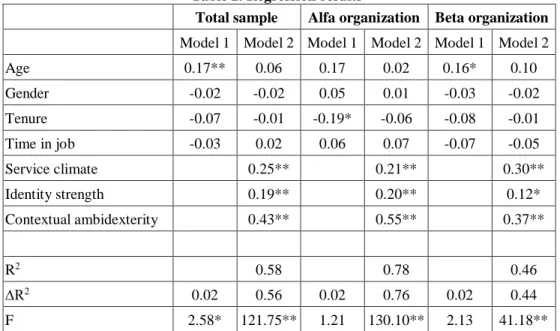
Conclusions
Along with careful selection practices targeting dual individuals, performance management and social support practices will lead to higher levels of contextual ambidexterity, a capacity that, in turn, will improve organizational performance. Furthermore, testing models that include moderator variables can contribute to capturing the effects of the great diversity of public organizations and their respective contexts. However, these are not the only ones that can be used to explain the performance of public organizations (Ciobanu, Androniceanu, 2018).
Strategic HR Practices: Introducing Alternatives for Performance Improvement of Public Sector Organizations. 2004). Evidence for a comprehensive model of organizational identification. Besides contributing to broadening the discussion on the antecedents of public organization performance, this study also supports the validity of the three theoretical perspectives. Identifying the factors influencing organizational performance thus becomes a fundamental undertaking for the sake of theory development and effective public management.
In this article, we join the discussion of what explains the performance of public organizations by studying specific organizational capacities or dimensions of the internal context according to the terminology of O'Toole and Meier (2014). In this article we try to answer the following question: which factors explain the performance of public organizations. This connection between service provider and service recipient is the essential element of an explanatory chain for organizational performance (Yagil, 2014): service-oriented management and leadership practices create a service climate that shapes employee attitudes and behaviors toward good service , which in turn affects organizational performance. on the service experience of customers, leading to satisfaction and loyalty, commonly used performance indicators (Van Ryzinand Immerwahr, 2007).
The concept of contextual ambidexterity is well established in the literature as an explanation for short- and long-term organizational performance (Simsek, 2009; O'Reilly and Tushman, 2013; Junni et al., 2013). The use of perceptual measures to assess organizational performance has a long tradition in organizational studies (Delaney and Huselid, 1996; Raymond et al., 2013; Kim, 2010) and is considered a valid psychometric approach (Wall et al., 2004) and appropriate. for public organizations (Andrews, Boyne and Walker, 2006). Perceived organizational performance is the variable to be explained and the other three are explanatory variables (Gay and Dihel, 1992).
Significant correlations between organizational performance and other study variables provide preliminary evidence supporting our hypothesis. This research aimed to examine the extent to which service climate, identity strength and contextual ambidexterity, seen as separate capabilities derived from very different but well-established theoretical traditions, influence the perceived performance of public organizations. In this study, we included three organizational capabilities with strong theoretical roots and relevant empirical evidence regarding their relationship with organizational performance.
Overall, the results provide additional empirical support for the three theoretical approaches in the study, namely the rich evidence regarding the effects of service climate on organizational performance (Hong, 2013), the empirical evidence reviewed by Junni et al. 2013) regarding the effects of ambidexterity on organizational performance, and to a lesser extent, studies that found a positive relationship between organizational identity and performance (Voss, Cable and Voss, 2006; Nunes et al., 2017). The three predictors of organizational performance we studied are generally statistically significant, but with unequal weights in Alpha and Beta organizations.
